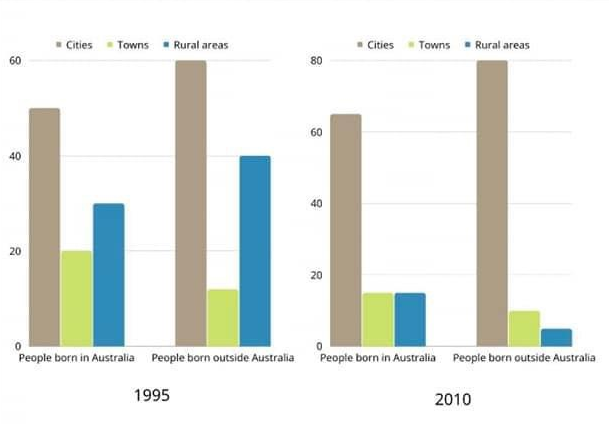[Kalyana Vineela M] Writing Practice Test 1339749
Task 1
You should spend about 20 minutes on this task.
The bar chart below describes some changes about the percentage of people were born in Australia and who were born outside Australia living in urban, rural and town between 1995 and 2010.
Summarise the information by selecting and reporting the main features and make comparisons where relevant.
You should write at least 150 words.

The given charts describe birth location of the urban, rural, and town population in Australia for a period of 15 years beginning 1995 onwards. It consolidates the data by comparing people who were born in and outside of Australia.
A quick look at the graphs present a clear trend that highest number of individuals residing in the cities were primarily not born in Australia. We can also ascertain from the visuals that there is a drastic change in the population in rural areas between 1995 and 2010. A vast majority of people who migrated from rural areas to cities came both from those who had their origins in Australia, as well as those who didn't.
A detailed investigation shows that in 1995, almost 60% of the city dwellers were the outsiders coming to Australia while people with Australian birth origin dwelling in the cities stood at 50%, making cities highly populated in the country. Following cities, the rural parts of Australia seemed to be densely populated. Australian origin, and non-native/ foreign birth origin residents in rural regions were at 30% and 40% respectively. The parts that had lesser population were the town regions, with only 20% Austrialian born residents, and 10% non-Australian born residents settling in such areas.
By 2010, the trends had flipped for town and rural areas. Residents from around the country migrated to the cities, shooting up the population to 65% and 80% each in the Austrialian birth origin and non-Australian birth origin categories respectively. This also meant a rapid decline in population in the towns and rural areas of Australia. The drop was close to 10% in the town for both native origin and non-native origin residents where only 15% and 10% of residents were left in each category of residents. But a steep decline of close to 20% and 35% was observed in rural areas dropping the residents in the rural regions to 15% and 5% in the Australian born, and outside Australia born categories of people.
Task 2
You should spend about 40 minutes on this task.
Rich countries often give money to poorer countries, but it does not solve poverty. Therefore, developed countries should give other types of help to the poor countries rather than financial aid. To what extent do you agree or disagree?
You should write at least 250 words.
Intro
Support extended by a developed country to the developing one has been always viewed as a welcoming gesture. Historically, there have been countless instances where financial aids have helped countries in settling down unrests, or set a course for unprecedented development. Hence, giving unrestricted financial aid, I feel is rather more promising for the undeveloped country.
It is an irrefutable fact that the countries receiving the aid have a better sense of how it should be usage for the nation's development. For instance, it is possible that a nation has a greater need for investment in infrastructural improvement. Their primary reasoning behind it could be to ease the current, and open more trade routes with the country to ease the economy and make it self-sustainable. Another example could be in the need to improve the communications system across the rural areas in the country. The thought behind it could be because of the simple need to connect residents in the areas to doctors virtually to ensure that have better medical care. Such nuances are better know to the developing country, making it essential to have unrestricted access to funds.
Adding to the above, to ensure that a country thrives to be self-reliant, and can open doors to more foreign partnerships, it is critical to keep research and innovation running consistently. A key example for this could be the pharmaceutical space, where the developing nation, the ability to invest in the production of its own medicine can significantly reduce the cost at which the medicines are then offered to general public. Similarly, the capacity to fund space technology allows the Global South countries to establish satellites that can serve as sophisticated weather warning systems to defence based intelligence tracking systems. Both of these focus on building the knowledge strength of the country that can present them as the super power in the years to come.
All in all, there are tremendous advantages to providing unrestricted financial funds to developing nations. These range from establishing and strong holding projects for public good, to projects that put them on the world map that showcase their scientific power, which there by increases their value. I certainly feel that letting go off the restrictions can add huge advantage to developing country.
Community’s feedback
Sorry! We couldn't find any contents.
Score Given by Community
Give a bandscoreLeaderboard:
| # | User | Score | Time | |
|---|---|---|---|---|
| Kento Nanami |  | 8.5 | 52:31 | |
| Nayef Alhajraf |  | 8.5 | 60:00 | |
| Ella Ruppo |  | 7.5 | 59:39 | |
| 4 | chengxi yu |  | 7.0 | 00:00 |
| 5 | avin chui |  | 7.0 | 59:11 |
| 6 | 癫 火 |  | 7.0 | 59:51 |
| 7 | Li Xuefeng |  | 6.5 | 03:46 |
| 8 | Chanisara Wongkongsang |  | 6.5 | 56:37 |
| 9 | Dan H |  | 6.0 | 50:41 |
| 10 | Carlo Di Giacomo |  | 6.0 | 60:00 |



